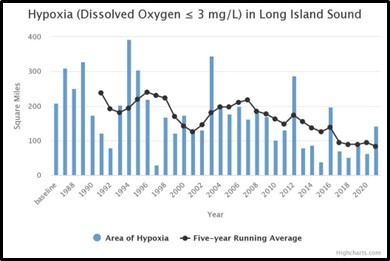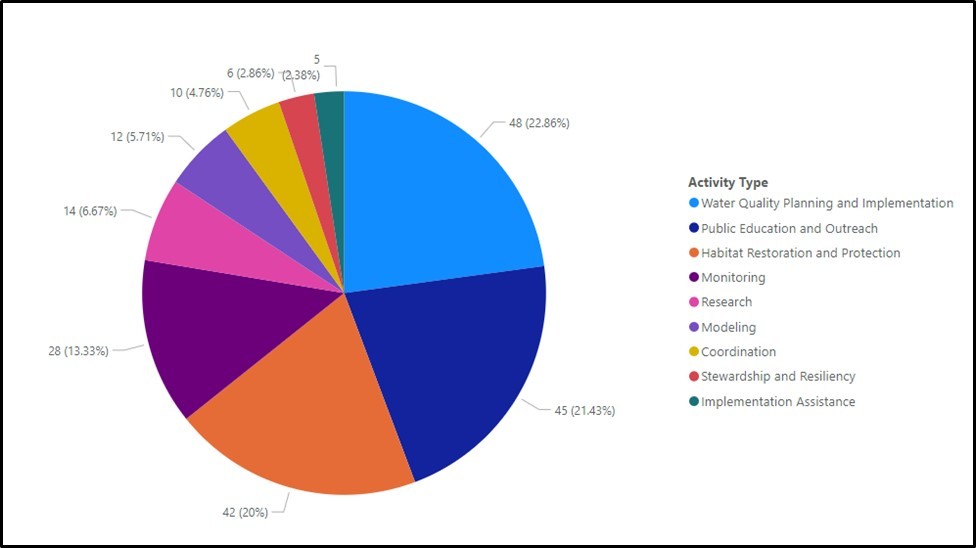
LISS $54M Budget Expands Opportunities to Fund a Wide Range of Sound Restoration Projects
The Long Island Sound Study Management Committee reached consensus on April 21 for a $54 million budget to fund projects for Long Island Sound restoration efforts, a 74 percent increase from 2021. A key component of the budget increase was the $105 million allocated ($21 million/year for five years) to LISS through the Bipartisan Infrastructure Law (BIL), passed by Congress last year. BIL funding will enable LISS and its partners to take on “shovel-ready” projects to benefit the Sound as well as plan and design projects in the future.
The 2022 Work Plan describes the LISS activities planned with 2022 federal funding. It also highlights projects undertaken with 2021 federal funds.
The Long Island Sound Futures Fund (LISFF)
The LISFF grant program supports implementation and planning projects to restore and protect the health of the Long Island Sound. Established in 2005, the LISFF has invested $32 million in 529 local and regional conservation projects. As a result of these projects 115 river miles have opened for fish migration, 805 acres of coastal habitat have been restored, 201 million gallons of stormwater pollution has been treated and 4 million people have been engaged through education and outreach.
In 2021 alone, $5.4 million was awarded to fund 39 projects resulting in an estimated 97,700 pounds of marine debris collected, 33 pounds of nitrogen prevented from polluting the Sound, and 290,000 people engaged through education and outreach.
For more details on the projects awarded in 2021 click here. The program is managed by the National Fish and Wildlife Foundation, and supported by the Long Island Sound Study, the Environmental Protection Agency, and the Long Island Sound Funders Collaborative.

Photo Credit: LISS
New Environmental Justice Grant
The Long Island Sound Study announced a new Environmental Justice program focused on the Long Island Sound watershed. The Long Island Sound Community Impact Fund (LISCIF) will direct funds and technical assistance to communities experiencing or affected by adverse and disproportionate environmental and human health risks or harms. EPA is seeking proposals from organizations to partner on launching the LISCIF and will provide up to $5 million for this program with Bipartisan Infrastructure Law funds. Applications are being accepted through Sept. 12, 2022. Learn more at grants.gov.
Sustainable and Resilient Communities
The Long Island Sound Study (LISS) has identified Sustainable and Resilient Communities (SRC) as one of four themes in its Comprehensive Conservation and Management Plan. Through the New York and Connecticut Sea Grant programs, a team of new professionals have been brought on board to build a coordinated regional response to current and future climate change impacts, empower better trained and informed community decision-makers, and increase implementation of resilience projects throughout the region.
Three new positions in New York, plus two in Connecticut, mark the growth of the program on both sides of the Sound. This team represents a commitment to prepare for and mitigate the effects of environmental and economic challenges posed by the effects of climate change and to expand community engagement along the Long Island.
This spring and summer the SRC extension professionals are talking to a wide variety of groups to understand how the LISS can support communities’ sustainability and resilience, and to advance relevant actions and projects in their communities. The information learned through these conversations will be used to provide support, training, and tools to empower and assist Long Island Sound communities in achieving their self-defined goals for sustainability and resilience.
To learn more about how this work can help your community or group please contact the NY SRC Extension Professional in your area.
Hypoxic Area Continues to Decline
Hypoxia refers to low or depleted oxygen in a water body, which occurs mainly in the summer, it is harmful to marine life and can cause fill kills and shellfish dies off. Hypoxia has been a significant problem in the Sound for decades. Although the annual numbers vary from year to year the long-term trend shows that the area of unhealthy hypoxic waters is shrinking in the Sound in response to reduced nitrogen pollution. The five-year running average is 83 square miles, the lowest since the time series began in 1991. Long Island Sound is now one of the few examples worldwide of a coastal ecosystem in recovery from nutrient-induced hypoxia. Since hotter summers can contribute to hypoxia there is a concern that improvements will not be sustained in the warming climate without continued intervention.

New Web Application to Measure Hypoxia
Hypoxia in the Sound has for many years been determined by measuring how much area of its bottom waters have 3mg of oxygen per liter or less (fish cannot survive in water with less oxygen) . Last year, the Connecticut Department of Energy and Environmental Protection and Professor James O’Donnell of the University of Connecticut unveiled a new web application to make exploring this data easier for users. Funded by LISS, the tool allows users to calculate both the hypoxic area and the volume of water. Volume is an important addition because it describes the extent of hypoxia throughout the water column, which better describes how it could impact organisms living in the hypoxic area.
Many wastewater treatment plants around the Sound have made significant upgrades to reduce the amount of nitrogen they discharge to the Sound. Using the new tool to evaluate 26 years of data, researchers concluded that despite the annual variability in the area and volume of hypoxia, there is convincing evidence that dissolved oxygen levels have improved over time due to the decrease in nitrogen loading from wastewater treatment plants in the western Sound.
LISS Funded Research Finds Link Between Low Oxygenated Waters, Excess Nitrogen, and Coastal Acidification
Coastal acidification is a growing problem and is linked to excess nitrogen. When the water becomes more acidic, shell-forming animals (e.g., coral, shellfish) struggle to properly form their shells, which impairs their development and ultimately their survival. These creatures are an important source of food for many animals, including humans. To address this problem, it is important to fully understand the connection between coastal acidification and excess nitrogen, and Dr. Penny Vlahos' LIS Respire project has confirmed and characterized that there is a strong connection. A new article for Sound Spotlight, highlights the work of Dr. Vlahos's research team, including evidence that the Sound's waters are growing more acidic, and the potential negative impact to water quality and shellfish. The article also looks at potential management solutions, and a new effort by the LISS to develop a soundwide monitoring network to measure acidification in order to keep track of the problem. Dr Vlahos’s study was funded by the Long Island Sound Study.

Photo Credit: LISS
Solute Transport Model
A Solute Transport Model is being developed for the entirety of Long Island. This will provide a wealth of information that will help guide local, state and regional management actions. The objective of the model is to understand historical and current nitrogen loads to the surface water. The modeling looks at water table fluctuation over time, water use, and nitrogen loading—as a function of changing land use and atmospheric deposition rates—from predevelopment (e.g., 1900) through the present. Once the model is developed, it will be used to run scenarios that will help decision makers understand how certain management actions might reduce nitrogen in the groundwater that will flow into marine waters. These results will help inform decisions about where and how nitrogen reducing efforts might be beneficial. It will also provide realistic expectations on when improvements might be seen, as the travel time of the groundwater in some areas is decades long.
The US Geological Survey (USGS), working with NYSDEC and the Peconic Estuary Program, developed the model for the eastern portion of Long Island. In 2021, the USGS extended the modeling to the central and western portions of Long Island, which covers parts of Kings, Queens, Nassau, and western Suffolk Counties. Once the model is complete for the entire Island, LISS will be able to use the model to predict how nitrogen reduction strategies will impact the Sound.
A Solute Transport Model Advisory Workgroup has been formed that brings together the appropriate representatives from relevant organizations to ensure the model is developed with the best available information and has input from all stakeholders. The workgroup members have been tasked with developing implementation scenarios that will guide how management decisions could be made.
Program Implementation and Progress Table Database
LISS's partners are undertaking hundreds of projects to help support the restoration goals of the Long Island Sound Comprehensive Conservation and Management Plan. Recently, the LISS website launched a Program Implementation and Progress Table and Database to make it simpler to find out the progress of projects. The database covers project from 2020 to today and includes a description of the project, activity type, goals and objectives, location, funding amount, and even the timeline for completion.
Take a look on the LISS website for a project near you!

This pie chart shows the number of ongoing projects by activity type: Water Quality Planning and Implementation, Public Education and Outreach, Habitat Restoration and Protection, Monitoring, Research, Modeling, Coordination, Stewardship and Resiliency, and Implementation Assistance. Source: LISS Program Implementation and Progress Table and Database
To sign up for our LINAP Newsletter, visit our LINAP webpage or click here.
|






